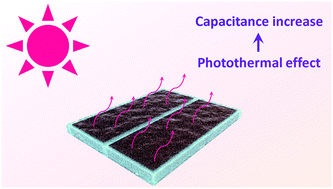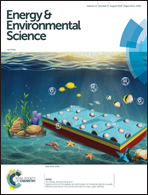Solar thermal-driven capacitance enhancement of supercapacitors†
Abstract
Solar energy is a renewable and abundant energy source that has myriad potential applications to be tapped. Energy storage devices often present diminishing performance at lower temperatures, and sometimes they even fail during cold weather; therefore, a renewable technology to spur such sluggish performance not only is important for a sustainable future but also may inspire new-concept devices such as ignition sensors. Here, under solar illumination, the capacitance, energy density and power density of supercapacitors are all largely enhanced owing to the photothermal effect. The supercapacitors employ three-dimensional hierarchical graphene as the electrodes, and show an absorption of >92.88% over the entire solar spectrum, a response time of <200 s, and a surface temperature change of ∼39 °C under 1 solar illumination (1 kW m−2). Under 1 solar illumination, the capacitance of the pseudocapacitor increases by ∼1.5 times, and the capacitance of the electric double-layer capacitor increases by ∼3.7 times. The mechanism is quantitatively analyzed and discussed. This work provides new insights into the applications of solar energy and offers new design options for the development of energy storage devices.



 Please wait while we load your content...
Please wait while we load your content...